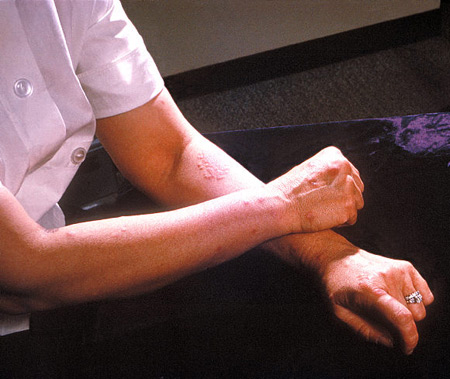History and exam
Key diagnostic factors
common
abdominal pain
May be cramp or constant pain. Above 70% patients experience abdominal pain at some point during the course of disease.[90][91]
Right lower quadrant and periumbilical regions are common locations if ileitis is present. May be partially relieved by defecation if there is colonic involvement.
Crohn colitis produces diffuse abdominal pain, which may be accompanied by mucus, blood, and pus in the stool.
prolonged diarrhea
Other diagnostic factors
common
bowel obstruction
Caused by acute inflammatory edema and spasm of the bowel or chronic scarring and stricture.
Manifests as bloating, distention, cramping abdominal pains, loud borborygmi, vomiting, constipation, and obstipation.
blood in stools
Rectal bleeding is more common in Crohn colitis.
fatigue
Caused by malnutrition, weight loss, and inflammation.
abdominal tenderness
Abdominal tenderness is a common manifestation of Crohn disease. It may be secondary to inflammation, localized collections, strictures causing small bowel or more rarely colonic obstruction, or proximal constipation.
Terminal ileal inflammation may present with localized right lower quadrant pain and tenderness.
weight loss
Unexplained weight loss may be seen.[9] Failure to thrive is common in children and may be a very early manifestation of the disease.
Malabsorption is a later cause of poor nutritional status.
uncommon
fever
Induced by the inflammation of Crohn disease or a complication such as perforation, abscess, or fistula.
oral lesions
abdominal mass
Terminal ileal inflammation may present as a tender mass in the right lower quadrant.
Proximal constipation may also be palpable as irregular stool mass on abdominal exam.
extraintestinal manifestations (e.g., erythema nodosum or pyoderma gangrenosum)
At least one extraintestinal manifestation occurs in about 50% of patients with inflammatory bowel disease.[8]
Manifestations may include symptoms and signs of arthropathy, cutaneous lesions (e.g., erythema nodosum, pyoderma gangrenosum), and ocular symptoms and signs (e.g., of anterior uveitis or episcleritis). [Figure caption and citation for the preceding image starts]: A patient's arms and hands show the presence of erythema nodosumCDC/ Margaret Renz [Citation ends]. The occurrence of thrombotic events in patients with Crohn disease is twice that of the general population.[8]
The occurrence of thrombotic events in patients with Crohn disease is twice that of the general population.[8]
Risk factors
strong
Ashkenazi Jewish ancestry
age 15-40 or 50-60 years
family history of CD
use of antibiotics
Studies have reported a significant association between antibiotic use and development of inflammatory bowel disease, particularly Crohn disease (CD).[58][59][60] One systematic review and meta-analysis found that compared with controls, odds of developing CD were higher in individuals who were exposed to antibiotics during childhood or had a lifetime exposure to antibiotics than in those who were not exposed to antibiotics (odds ratio 1.52 [1.23 to 1.87]; P <0.00001).[60]
weak
cigarette smoking
diet high in refined sugar
diet low in fiber
diet high in ultra-processed foods
use of oral contraceptives
One meta-analysis of case-controlled and cohort studies reported a 24% increase in risk of developing Crohn disease (CD) in those taking oral contraceptives compared with those not taking them.[35] One nested case-control study reported that the use of combined oral contraceptive pills was associated with CD development.[41] However, an association with CD was not noted for progesterone-only pills.[41]
not breastfed
Use of this content is subject to our disclaimer